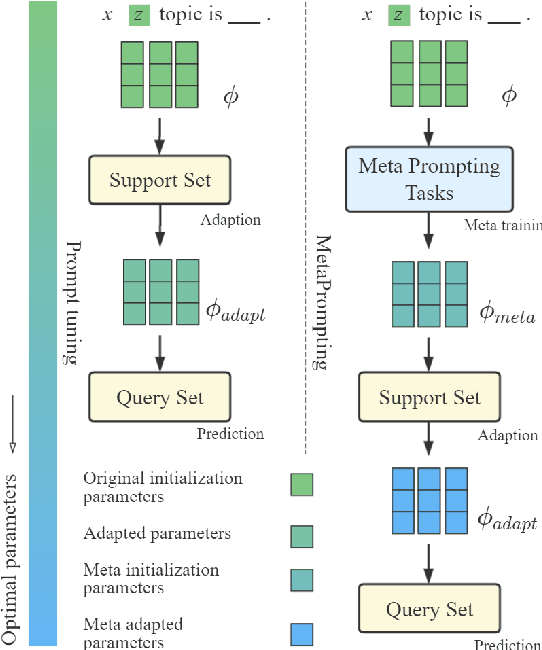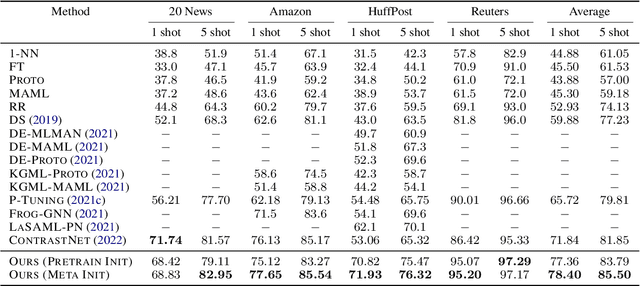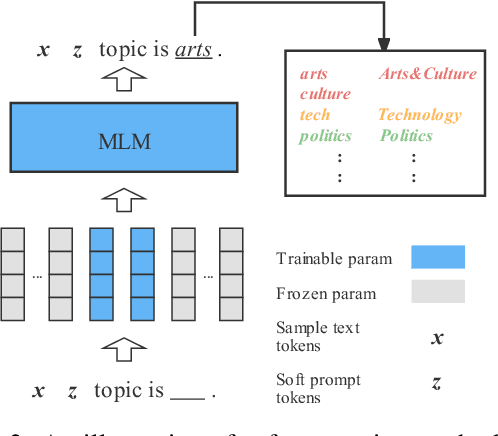Xinghao Wang
UnifiedVisual: A Framework for Constructing Unified Vision-Language Datasets
Sep 18, 2025Abstract:Unified vision large language models (VLLMs) have recently achieved impressive advancements in both multimodal understanding and generation, powering applications such as visual question answering and text-guided image synthesis. However, progress in unified VLLMs remains constrained by the lack of datasets that fully exploit the synergistic potential between these two core abilities. Existing datasets typically address understanding and generation in isolation, thereby limiting the performance of unified VLLMs. To bridge this critical gap, we introduce a novel dataset construction framework, UnifiedVisual, and present UnifiedVisual-240K, a high-quality dataset meticulously designed to facilitate mutual enhancement between multimodal understanding and generation. UnifiedVisual-240K seamlessly integrates diverse visual and textual inputs and outputs, enabling comprehensive cross-modal reasoning and precise text-to-image alignment. Our dataset encompasses a wide spectrum of tasks and data sources, ensuring rich diversity and addressing key shortcomings of prior resources. Extensive experiments demonstrate that models trained on UnifiedVisual-240K consistently achieve strong performance across a wide range of tasks. Notably, these models exhibit significant mutual reinforcement between multimodal understanding and generation, further validating the effectiveness of our framework and dataset. We believe UnifiedVisual represents a new growth point for advancing unified VLLMs and unlocking their full potential. Our code and datasets is available at https://github.com/fnlp-vision/UnifiedVisual.
Decoupled Proxy Alignment: Mitigating Language Prior Conflict for Multimodal Alignment in MLLM
Sep 18, 2025Abstract:Multimodal large language models (MLLMs) have gained significant attention due to their impressive ability to integrate vision and language modalities. Recent advancements in MLLMs have primarily focused on improving performance through high-quality datasets, novel architectures, and optimized training strategies. However, in this paper, we identify a previously overlooked issue, language prior conflict, a mismatch between the inherent language priors of large language models (LLMs) and the language priors in training datasets. This conflict leads to suboptimal vision-language alignment, as MLLMs are prone to adapting to the language style of training samples. To address this issue, we propose a novel training method called Decoupled Proxy Alignment (DPA). DPA introduces two key innovations: (1) the use of a proxy LLM during pretraining to decouple the vision-language alignment process from language prior interference, and (2) dynamic loss adjustment based on visual relevance to strengthen optimization signals for visually relevant tokens. Extensive experiments demonstrate that DPA significantly mitigates the language prior conflict, achieving superior alignment performance across diverse datasets, model families, and scales. Our method not only improves the effectiveness of MLLM training but also shows exceptional generalization capabilities, making it a robust approach for vision-language alignment. Our code is available at https://github.com/fnlp-vision/DPA.
Context-Aware Weakly Supervised Image Manipulation Localization with SAM Refinement
Mar 26, 2025Abstract:Malicious image manipulation poses societal risks, increasing the importance of effective image manipulation detection methods. Recent approaches in image manipulation detection have largely been driven by fully supervised approaches, which require labor-intensive pixel-level annotations. Thus, it is essential to explore weakly supervised image manipulation localization methods that only require image-level binary labels for training. However, existing weakly supervised image manipulation methods overlook the importance of edge information for accurate localization, leading to suboptimal localization performance. To address this, we propose a Context-Aware Boundary Localization (CABL) module to aggregate boundary features and learn context-inconsistency for localizing manipulated areas. Furthermore, by leveraging Class Activation Mapping (CAM) and Segment Anything Model (SAM), we introduce the CAM-Guided SAM Refinement (CGSR) module to generate more accurate manipulation localization maps. By integrating two modules, we present a novel weakly supervised framework based on a dual-branch Transformer-CNN architecture. Our method achieves outstanding localization performance across multiple datasets.
SeisMoLLM: Advancing Seismic Monitoring via Cross-modal Transfer with Pre-trained Large Language Model
Feb 27, 2025



Abstract:Recent advances in deep learning have revolutionized seismic monitoring, yet developing a foundation model that performs well across multiple complex tasks remains challenging, particularly when dealing with degraded signals or data scarcity. This work presents SeisMoLLM, the first foundation model that utilizes cross-modal transfer for seismic monitoring, to unleash the power of large-scale pre-training from a large language model without requiring direct pre-training on seismic datasets. Through elaborate waveform tokenization and fine-tuning of pre-trained GPT-2 model, SeisMoLLM achieves state-of-the-art performance on the DiTing and STEAD datasets across five critical tasks: back-azimuth estimation, epicentral distance estimation, magnitude estimation, phase picking, and first-motion polarity classification. It attains 36 best results out of 43 task metrics and 12 top scores out of 16 few-shot generalization metrics, with many relative improvements ranging from 10% to 50%. In addition to its superior performance, SeisMoLLM maintains efficiency comparable to or even better than lightweight models in both training and inference. These findings establish SeisMoLLM as a promising foundation model for practical seismic monitoring and highlight cross-modal transfer as an exciting new direction for earthquake studies, showcasing the potential of advanced deep learning techniques to propel seismology research forward.
BitStack: Fine-Grained Size Control for Compressed Large Language Models in Variable Memory Environments
Oct 31, 2024



Abstract:Large language models (LLMs) have revolutionized numerous applications, yet their deployment remains challenged by memory constraints on local devices. While scaling laws have enhanced LLM capabilities, the primary bottleneck has shifted from \textit{capability} to \textit{availability}, emphasizing the need for efficient memory management. Traditional compression methods, such as quantization, often require predefined compression ratios and separate compression processes for each setting, complicating deployment in variable memory environments. In this paper, we introduce \textbf{BitStack}, a novel, training-free weight compression approach that enables megabyte-level trade-offs between memory usage and model performance. By leveraging weight decomposition, BitStack can dynamically adjust the model size with minimal transmission between running memory and storage devices. Our approach iteratively decomposes weight matrices while considering the significance of each parameter, resulting in an approximately 1-bit per parameter residual block in each decomposition iteration. These blocks are sorted and stacked in storage as basic transmission units, with different quantities loaded based on current memory availability. Extensive experiments across a wide range of tasks demonstrate that, despite offering fine-grained size control, BitStack consistently matches or surpasses strong quantization baselines, particularly at extreme compression ratios. To the best of our knowledge, this is the first decomposition-based method that effectively bridges the gap to practical compression techniques like quantization. Code is available at https://github.com/xinghaow99/BitStack.
Concise and Precise Context Compression for Tool-Using Language Models
Jul 02, 2024



Abstract:Through reading the documentation in the context, tool-using language models can dynamically extend their capability using external tools. The cost is that we have to input lengthy documentation every time the model needs to use the tool, occupying the input window as well as slowing down the decoding process. Given the progress in general-purpose compression, soft context compression is a suitable approach to alleviate the problem. However, when compressing tool documentation, existing methods suffer from the weaknesses of key information loss (specifically, tool/parameter name errors) and difficulty in adjusting the length of compressed sequences based on documentation lengths. To address these problems, we propose two strategies for compressing tool documentation into concise and precise summary sequences for tool-using language models. 1) Selective compression strategy mitigates key information loss by deliberately retaining key information as raw text tokens. 2) Block compression strategy involves dividing tool documentation into short chunks and then employing a fixed-length compression model to achieve variable-length compression. This strategy facilitates the flexible adjustment of the compression ratio. Results on API-Bank and APIBench show that our approach reaches a performance comparable to the upper-bound baseline under up to 16x compression ratio.
DenoSent: A Denoising Objective for Self-Supervised Sentence Representation Learning
Jan 24, 2024



Abstract:Contrastive-learning-based methods have dominated sentence representation learning. These methods regularize the representation space by pulling similar sentence representations closer and pushing away the dissimilar ones and have been proven effective in various NLP tasks, e.g., semantic textual similarity (STS) tasks. However, it is challenging for these methods to learn fine-grained semantics as they only learn from the inter-sentence perspective, i.e., their supervision signal comes from the relationship between data samples. In this work, we propose a novel denoising objective that inherits from another perspective, i.e., the intra-sentence perspective. By introducing both discrete and continuous noise, we generate noisy sentences and then train our model to restore them to their original form. Our empirical evaluations demonstrate that this approach delivers competitive results on both semantic textual similarity (STS) and a wide range of transfer tasks, standing up well in comparison to contrastive-learning-based methods. Notably, the proposed intra-sentence denoising objective complements existing inter-sentence contrastive methodologies and can be integrated with them to further enhance performance. Our code is available at https://github.com/xinghaow99/DenoSent.
InferAligner: Inference-Time Alignment for Harmlessness through Cross-Model Guidance
Jan 20, 2024



Abstract:With the rapid development of large language models (LLMs), they are not only used as general-purpose AI assistants but are also customized through further fine-tuning to meet the requirements of different applications. A pivotal factor in the success of current LLMs is the alignment process. Current alignment methods, such as supervised fine-tuning (SFT) and reinforcement learning from human feedback (RLHF), focus on training-time alignment and are often complex and cumbersome to implement. Therefore, we develop \textbf{InferAligner}, a novel inference-time alignment method that utilizes cross-model guidance for harmlessness alignment. InferAligner utilizes safety steering vectors extracted from safety-aligned model to modify the activations of the target model when responding to harmful inputs, thereby guiding the target model to provide harmless responses. Experimental results show that our method can be very effectively applied to domain-specific models in finance, medicine, and mathematics, as well as to multimodal large language models (MLLMs) such as LLaVA. It significantly diminishes the Attack Success Rate (ASR) of both harmful instructions and jailbreak attacks, while maintaining almost unchanged performance in downstream tasks.
Semantic-Guided Image Augmentation with Pre-trained Models
Feb 04, 2023



Abstract:Image augmentation is a common mechanism to alleviate data scarcity in computer vision. Existing image augmentation methods often apply pre-defined transformations or mixup to augment the original image, but only locally vary the image. This makes them struggle to find a balance between maintaining semantic information and improving the diversity of augmented images. In this paper, we propose a Semantic-guided Image augmentation method with Pre-trained models (SIP). Specifically, SIP constructs prompts with image labels and captions to better guide the image-to-image generation process of the pre-trained Stable Diffusion model. The semantic information contained in the original images can be well preserved, and the augmented images still maintain diversity. Experimental results show that SIP can improve two commonly used backbones, i.e., ResNet-50 and ViT, by 12.60% and 2.07% on average over seven datasets, respectively. Moreover, SIP not only outperforms the best image augmentation baseline RandAugment by 4.46% and 1.23% on two backbones, but also further improves the performance by integrating naturally with the baseline. A detailed analysis of SIP is presented, including the diversity of augmented images, an ablation study on textual prompts, and a case study on the generated images.
MetaPrompting: Learning to Learn Better Prompts
Sep 27, 2022



Abstract:Prompting method is regarded as one of the crucial progress for few-shot nature language processing. Recent research on prompting moves from discrete tokens based ``hard prompts'' to continuous ``soft prompts'', which employ learnable vectors as pseudo prompt tokens and achieve better performance. Though showing promising prospects, these soft-prompting methods are observed to rely heavily on good initialization to take effect. Unfortunately, obtaining a perfect initialization for soft prompts requires understanding of inner language models working and elaborate design, which is no easy task and has to restart from scratch for each new task. To remedy this, we propose a generalized soft prompting method called MetaPrompting, which adopts the well-recognized model-agnostic meta-learning algorithm to automatically find better prompt initialization that facilitates fast adaptation to new prompting tasks.Extensive experiments show MetaPrompting tackles soft prompt initialization problem and brings significant improvement on four different datasets (over 6 points improvement in accuracy for 1-shot setting), achieving new state-of-the-art performance.
 Add to Chrome
Add to Chrome Add to Firefox
Add to Firefox Add to Edge
Add to Edge